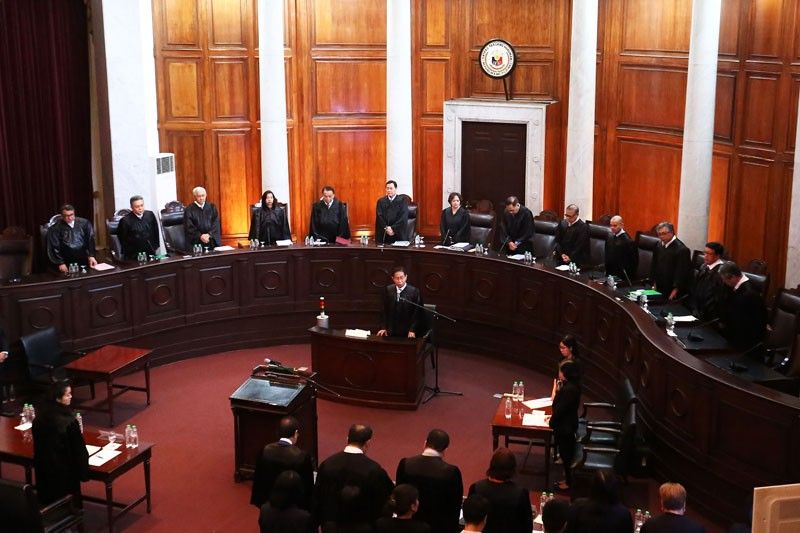Final analysis on employer-employee relationship test
The Supreme Court has always recognized the fact that the question of whether or not an employer-employee relationship exists in a certain situation continues to bedevil the courts. Some businessmen with the aid of lawyers have tried to avoid the bringing about of an employer-employee relationship in some of their enterprises because that juridical relation spawns obligations connected with workmen’s compensation, social security, medicare, minimum wage, termination pay and unionism.[1] In resolving the issue of whether an employer-employee tie obtains, case law has mostly been focused on the four-fold test on employment. This test has been developed and invariably invoked by labor officials and the Supreme Court as a guiding, if not governing, norm in order to determine, based on the facts and circumstances involved in a given situation, whether such relationship exists. These four elements are:
In resolving the issue of whether an employer-employee tie obtains, case law has mostly been focused on the four-fold test on employment. This test has been developed and invariably invoked by labor officials and the Supreme Court as a guiding, if not governing, norm in order to determine, based on the facts and circumstances involved in a given situation, whether such relationship exists. These four elements are:
(1) The selection and engagement of the employee;
(2) The payment of wages;
(3) The power of dismissal; and
(4) The control test.
The control test -- meaning: whether or not the employer controls or has reserved the right to control the employee not only as to the result of the work to be done but also the means and methods employed in reaching that end-- is said to be the most important index of the existence of an employer-employee relationship.
The reason why the control test is the most important indicator of employment relations is the fact that the employee is treated as an agent of the employer in the conduct of the day-to-day operations of the enterprise. As such, the employer may be bound by the actions of the employee in the course of the latter's duties. Hence, it is is reasonable for the employer to exercise a certain degree of control over employees, which is higher than the degree of control in other contracts and in other relationships.
Imagine a continuum between "no control" on the farthest left and "full control" on the farthest right, viz:

"No control" can be used to describe the relationship between two persons strangers to each other; there is no control whatsoever that one can exercise over the other. On the other hand, "complete control" can be used to describe the relationship between the President and the executive alter egos; the former can modify or completely abandon the decisions of the latter.
On this scale, where does the employer's right of control lie?
First, analysis must be made on the aspects of the employee's work life that may be controlled by the employer. It is clear from jurisprudence that the employer's right of control extends not only to the results but also to the means and methods of achieving said results.[2] Hence, if the right of control is reserved or exercised over the results only, there is no employment relation.
Most students forget that the employer's right of control also covers the three other factors in the four-fold test: selection and engagement; payment of wages; and power of dismissal. The employer controls the hiring process, subject to certain limitations provided by law. The employer controls how employees are paid and how much, subject to minimum statutory standards. The employer also controls who gets fired and who does not, limited to certain broadly-worded grounds provided under the Labor Code[3] such as "serious misconduct," "breach of trust" and "willful disobedience."[4]
The power of selection and engagement can also be interpreted to cover the power and prerogative of management to decide on personnel movement. The employer decides who stays in the plantilla and who gets promoted to join the managerial staff. The employer decides how many duties an employee should have, as long as such decision is not attended by bad faith or perpetrated to defeat labor laws.
The duty to pay wages includes the power to pay wages. As long as the minimum benefits provided by law are given by the employer to employees, no violation is committed. Hence, it is the discretion of the employer to shower certain employees with bonuses, incentives or perks while depriving others of the same, which is usually done by employers based on performance. The employer can even decide to double or triple the 13th month pay of one or two employees while that of other employees remain along the barest minimum required by law.
The power of dismissal, as long as wielded in accordance with the minimum guidelines provided by law, is also a powerful tool. For example, an employee who has contributed thousands of policy proposals to the enterprise, thereby allowing the employer to take in millions of pesos in profits, may be treated lightly by an employer despite an allegation of serious misconduct or despite the obvious presence of willful disobedience; after all, there is a thin line that separates genius from unpleasant character. On the other hand, a similar insubordination or misconduct from a different employee who has no contribution at all to the company may be treated differently by the employer. Of course, objections as to equal protection may be raised but the wide latitude given by law to capital in controlling its business is an argument with similar persuasiveness.
At the bottom of all these, it can be seen that, within the realm of employment, the employer has 9 out of 10 on the scale of control continuum. The only factor that keeps it from reaching 10 out of 10 is the law that provides minimum standards and protection to the workers. The extent of employment control allowed by law even tolerates micromanagement of workers (which, of course, is never encouraged in business and management school). The point is: absent the law and all good management principles and practices, the right of control may reach a potential 10 out of 10 on the scale of control continuum as shown above, of course, only in the realm of employment.
Of course, control can be exercised in other relationships. Parents exercise control over their children. Principals have control over their agents. Lessors reserve a certain degree of control over lessees. No less than the Supreme Court recognized that, in fact, "results-wise, the principal can impose production quotas and can determine how many agents, with specific territories, ought to be employed to achieve the company’s objectives. These are management policy decisions that the labor law element of control cannot reach."[5] Summarizing its findings, the High Court said: "Not every form of control that a hiring party imposes on the hired party is indicative of employee-employer relationship. Rules and regulations that merely serve as guidelines towards the achievement of a mutually desired result without dictating the means and methods of accomplishing it do not establish employer-employee relationship."[6]
The control contemplated by labor laws between employers and employees is more than mere guidelines. The right control reserved or exercised must not be detached from the traditional concept of the employee being hired, supervised, and paid by the employer.[7] The traditional view puts emphasis on direct, physical control or contractual rights of control.[8]
Beyond the above-discussed traditional concept, some jurisdictions have also adopted "factors," "indicators" or "hallmarks" of employment relations. According to the International Labour Organization (ILO), various "factors are used in many countries to determine the existence of an employment relationship. While these factors vary, some of the more common factors include the level of subordination to the employer, work for the benefit of another person, and work under instruction. In some cases, the law goes one step further, and classifies certain workers as employees whose situation could be ambiguous, or provides for a presumption in their case that there is an employment relationship. Conversely, legislation may specify that certain contractual arrangements are not employment relationships."[9]
"In some legal systems, certain indicators are relied on to identify whether or not the relevant factors are present to determine the existence of an employment relationship. These indicators include the extent of integration in an organization, who controls the conditions of work, the provision of tools, materials or machinery, the provision of training and whether the remuneration is paid periodically and constitutes a significant proportion of the income of the worker. In common law countries, judges base their rulings on certain tests developed by case law, for example the tests of control, integration in the enterprise, economic reality, who bears the financial risk, and mutuality of obligation. In all systems, the judge must normally decide on the basis of the facts, irrespective of how the parties construe or describe a given contractual relationship."[10]
[1] https://ift.tt/3teCRNr.
[2] https://ift.tt/3h48Awa.
[3] Presidential Decree No. 442.
[4] https://ift.tt/2YhBRwE.
[5] https://ift.tt/3jJ0zP1.
[6] Id., citing Insular Life Assurance Co., Ltd. v. National Labor Relations Commission, 259 Phil. 65, 70-71 (1989).
[7] https://ift.tt/38C8BCV.
[8] Patricia Ball, Comment, The New Traditional Employment Relationship: An Examination of Proposed Legal and Structural Reforms for Contingent Workers From the Perspectives of Involuntary Impermanent Workers and Those Who Employ Them, 43 Santa Clara L. Rev. 901 (2003). Available at: https://ift.tt/2WT61WM.
[9] ILO. (2006). Employment Relationship: The. International Labour Conference. 95th Session 2006. Report V (2B)/Relation de Travail, Le. Conférence Internationale Du Travail. 95e Session 2006. Rapport V (2B).. International Labour Conference. 95th Session 2006. Report V (2B)/Relation de Travail. International Labour Organization. Available at: https://ift.tt/38UsLZ3.
[10] ILO. (2006). Employment Relationship: The. International Labour Conference. 95th Session 2006. Report V (2B)/Relation de Travail, Le. Conférence Internationale Du Travail. 95e Session 2006. Rapport V (2B).. International Labour Conference. 95th Session 2006. Report V (2B)/Relation de Travail. International Labour Organization. Available at: https://ift.tt/38UsLZ3.
 In resolving the issue of whether an employer-employee tie obtains, case law has mostly been focused on the four-fold test on employment. This test has been developed and invariably invoked by labor officials and the Supreme Court as a guiding, if not governing, norm in order to determine, based on the facts and circumstances involved in a given situation, whether such relationship exists. These four elements are:
In resolving the issue of whether an employer-employee tie obtains, case law has mostly been focused on the four-fold test on employment. This test has been developed and invariably invoked by labor officials and the Supreme Court as a guiding, if not governing, norm in order to determine, based on the facts and circumstances involved in a given situation, whether such relationship exists. These four elements are:(1) The selection and engagement of the employee;
(2) The payment of wages;
(3) The power of dismissal; and
(4) The control test.
The control test -- meaning: whether or not the employer controls or has reserved the right to control the employee not only as to the result of the work to be done but also the means and methods employed in reaching that end-- is said to be the most important index of the existence of an employer-employee relationship.
The reason why the control test is the most important indicator of employment relations is the fact that the employee is treated as an agent of the employer in the conduct of the day-to-day operations of the enterprise. As such, the employer may be bound by the actions of the employee in the course of the latter's duties. Hence, it is is reasonable for the employer to exercise a certain degree of control over employees, which is higher than the degree of control in other contracts and in other relationships.
Imagine a continuum between "no control" on the farthest left and "full control" on the farthest right, viz:

"No control" can be used to describe the relationship between two persons strangers to each other; there is no control whatsoever that one can exercise over the other. On the other hand, "complete control" can be used to describe the relationship between the President and the executive alter egos; the former can modify or completely abandon the decisions of the latter.
On this scale, where does the employer's right of control lie?
First, analysis must be made on the aspects of the employee's work life that may be controlled by the employer. It is clear from jurisprudence that the employer's right of control extends not only to the results but also to the means and methods of achieving said results.[2] Hence, if the right of control is reserved or exercised over the results only, there is no employment relation.
Most students forget that the employer's right of control also covers the three other factors in the four-fold test: selection and engagement; payment of wages; and power of dismissal. The employer controls the hiring process, subject to certain limitations provided by law. The employer controls how employees are paid and how much, subject to minimum statutory standards. The employer also controls who gets fired and who does not, limited to certain broadly-worded grounds provided under the Labor Code[3] such as "serious misconduct," "breach of trust" and "willful disobedience."[4]
The power of selection and engagement can also be interpreted to cover the power and prerogative of management to decide on personnel movement. The employer decides who stays in the plantilla and who gets promoted to join the managerial staff. The employer decides how many duties an employee should have, as long as such decision is not attended by bad faith or perpetrated to defeat labor laws.
The duty to pay wages includes the power to pay wages. As long as the minimum benefits provided by law are given by the employer to employees, no violation is committed. Hence, it is the discretion of the employer to shower certain employees with bonuses, incentives or perks while depriving others of the same, which is usually done by employers based on performance. The employer can even decide to double or triple the 13th month pay of one or two employees while that of other employees remain along the barest minimum required by law.
The power of dismissal, as long as wielded in accordance with the minimum guidelines provided by law, is also a powerful tool. For example, an employee who has contributed thousands of policy proposals to the enterprise, thereby allowing the employer to take in millions of pesos in profits, may be treated lightly by an employer despite an allegation of serious misconduct or despite the obvious presence of willful disobedience; after all, there is a thin line that separates genius from unpleasant character. On the other hand, a similar insubordination or misconduct from a different employee who has no contribution at all to the company may be treated differently by the employer. Of course, objections as to equal protection may be raised but the wide latitude given by law to capital in controlling its business is an argument with similar persuasiveness.
At the bottom of all these, it can be seen that, within the realm of employment, the employer has 9 out of 10 on the scale of control continuum. The only factor that keeps it from reaching 10 out of 10 is the law that provides minimum standards and protection to the workers. The extent of employment control allowed by law even tolerates micromanagement of workers (which, of course, is never encouraged in business and management school). The point is: absent the law and all good management principles and practices, the right of control may reach a potential 10 out of 10 on the scale of control continuum as shown above, of course, only in the realm of employment.
Of course, control can be exercised in other relationships. Parents exercise control over their children. Principals have control over their agents. Lessors reserve a certain degree of control over lessees. No less than the Supreme Court recognized that, in fact, "results-wise, the principal can impose production quotas and can determine how many agents, with specific territories, ought to be employed to achieve the company’s objectives. These are management policy decisions that the labor law element of control cannot reach."[5] Summarizing its findings, the High Court said: "Not every form of control that a hiring party imposes on the hired party is indicative of employee-employer relationship. Rules and regulations that merely serve as guidelines towards the achievement of a mutually desired result without dictating the means and methods of accomplishing it do not establish employer-employee relationship."[6]
The control contemplated by labor laws between employers and employees is more than mere guidelines. The right control reserved or exercised must not be detached from the traditional concept of the employee being hired, supervised, and paid by the employer.[7] The traditional view puts emphasis on direct, physical control or contractual rights of control.[8]
Beyond the above-discussed traditional concept, some jurisdictions have also adopted "factors," "indicators" or "hallmarks" of employment relations. According to the International Labour Organization (ILO), various "factors are used in many countries to determine the existence of an employment relationship. While these factors vary, some of the more common factors include the level of subordination to the employer, work for the benefit of another person, and work under instruction. In some cases, the law goes one step further, and classifies certain workers as employees whose situation could be ambiguous, or provides for a presumption in their case that there is an employment relationship. Conversely, legislation may specify that certain contractual arrangements are not employment relationships."[9]
"In some legal systems, certain indicators are relied on to identify whether or not the relevant factors are present to determine the existence of an employment relationship. These indicators include the extent of integration in an organization, who controls the conditions of work, the provision of tools, materials or machinery, the provision of training and whether the remuneration is paid periodically and constitutes a significant proportion of the income of the worker. In common law countries, judges base their rulings on certain tests developed by case law, for example the tests of control, integration in the enterprise, economic reality, who bears the financial risk, and mutuality of obligation. In all systems, the judge must normally decide on the basis of the facts, irrespective of how the parties construe or describe a given contractual relationship."[10]
[1] https://ift.tt/3teCRNr.
[2] https://ift.tt/3h48Awa.
[3] Presidential Decree No. 442.
[4] https://ift.tt/2YhBRwE.
[5] https://ift.tt/3jJ0zP1.
[6] Id., citing Insular Life Assurance Co., Ltd. v. National Labor Relations Commission, 259 Phil. 65, 70-71 (1989).
[7] https://ift.tt/38C8BCV.
[8] Patricia Ball, Comment, The New Traditional Employment Relationship: An Examination of Proposed Legal and Structural Reforms for Contingent Workers From the Perspectives of Involuntary Impermanent Workers and Those Who Employ Them, 43 Santa Clara L. Rev. 901 (2003). Available at: https://ift.tt/2WT61WM.
[9] ILO. (2006). Employment Relationship: The. International Labour Conference. 95th Session 2006. Report V (2B)/Relation de Travail, Le. Conférence Internationale Du Travail. 95e Session 2006. Rapport V (2B).. International Labour Conference. 95th Session 2006. Report V (2B)/Relation de Travail. International Labour Organization. Available at: https://ift.tt/38UsLZ3.
[10] ILO. (2006). Employment Relationship: The. International Labour Conference. 95th Session 2006. Report V (2B)/Relation de Travail, Le. Conférence Internationale Du Travail. 95e Session 2006. Rapport V (2B).. International Labour Conference. 95th Session 2006. Report V (2B)/Relation de Travail. International Labour Organization. Available at: https://ift.tt/38UsLZ3.








0 Comments